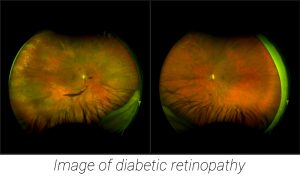Eye Conditions
Age-related Macular Degeneration (AMD)
AMD is a chronic progressive disease that affects the center of the retina in the back of the eye called the macula. The macula is responsible for sharp, detailed, central vision needed for everyday activities. In AMD, patients start to lose their central vision and have trouble seeing fine details both near and far.
AMD is common, it is the leading cause of vision loss in people 50 years or older. AMD typically causes no symptoms until vision begins to fade. Because of this, routine eye exams are important for catching AMD as early as possible.
The biggest risk factor for AMD is age, the second greatest risk factor is having a family history of AMD. Other risk factors include; caucasian descent, smoker or history of smoking, prolonged sun exposure, poor diet, heart disease, high blood pressure, and high cholesterol.
Glaucoma
Glaucoma is an eye disease that causes damage to the optic nerve that connects from your eye to your brain. This can happen when fluid builds up in the eye causing an increase in eye pressure and damage to the optic nerve by loss of nerve fibers. Loss of nerve fibers in glaucoma is irreversible and can cause visual field loss and blindness.
In most cases, there are no warning signs or obvious symptoms in the early stages of glaucoma. Regular exams are important to check your eye pressure and examine your optic nerve to screen for early signs of glaucoma. Blindness from glaucoma can often be prevented with early intervention and treatment.
Cataracts
A cataract is a progressive clouding of the normally clear lens inside the eye. Usually, the first sign of a cataract developing is increased glare, especially at night. As the cataract progresses, your vision will become blurrier both near and far and it may become harder to perform normal daily tasks. When cataracts disrupt your daily life, your doctor may recommend cataract-removal surgery, which is one of the most frequent and successful procedures done in the U.S.
At your comprehensive eye exam, your eye care provider will test your visual acuity and use the slit lamp to evaluate the lens inside your eye to check you for cataracts.
Diabetic Retinopathy
Diabetic retinopathy is caused from type 1 or type 2 Diabetes. Elevated blood sugar in diabetic patients can cause damage to blood vessels in the back of the eye (retina). These blood vessels can swell and leak, causing hemorrhages and microaneurysms. This can also cause swelling in the center of the retina (macula), called macular edema.
Often there are no symptoms in the early stages of diabetic retinopathy, so it is important that Individuals with diabetes have their eyes evaluated at least once a year. Early detection and treatment of diabetic retinopathy will dramatically reduce your chances of sustaining permanent vision loss.

Amblyopia
Lazy eye, medically known as amblyopia, is a loss or lack of development of vision, usually in one eye. Amblyopia typically develops during childhood from strabismus (eye turn), high refractive error, congenital cataract, or ptosis (droopy eyelid). The first few years of a child’s life is critical to developing normal, healthy vision. During early childhood, if there is visual impairment in one or both eyes, the visual pathway from the eye back to the brain cannot fully develop. The brain may ignore the weaker eye permanently, leading to reduced vision in the affected eye or eyes.
Lazy eye is not always recognized at home or by the pediatrician, and the child may not display any obvious symptoms. Because of this, it is recommended that all children, including those with no symptoms, have a comprehensive eye examination by the age of three and sooner if they were born prematurely or if there is a family history of any eye condition or disease.
Computer Vision Syndrome
Computer Vision Syndrome is the name given to eye problems caused by prolonged computer use. These symptoms include; eye irritation, blurred vision, headaches, neck pain, back pain, stiff shoulders, and eye strain.
These symptoms can be alleviated by postural changes, adjustment in eyeglass or contact lens prescription, environmental and lighting changes, and dry eye treatment.
Did you know that Costco optical offers a multifunctional computer progressive? These lenses optimize your intermediate and near vision by creating a wide zone for computer distance at the top of the lens and a reading zone at the bottom of the lens. This helps you see your computer screen with much less strain and effort than traditional progressive lenses.
Dry Eye
Dry eye occurs when the eye does not produce enough tears, or the quality of the tears is poor causing an unstable tear film. Our eyes need a healthy tear film to stay healthy and comfortable. Symptoms of dry eye include; burning, watering, irritation, foreign body sensation or “gritty” feeling, blurred vision, red eyes, unstable vision or changes in vision with blinking, and intolerance to contact lenses.
People tend to produce fewer tears as they get older, and dry eyes tend to be more common in women – especially those who have gone through menopause. Other causes of dry eye include; autoimmune conditions, certain medications, staring at a screen for prolonged periods of time, contact lens wear, history of refractive eye surgery, and hormonal changes.
Let your eye doctor know if you suspect that you have dry eye. Proper care will not only increase your comfort but it will protect your eyes long-term. Your eye care provider will evaluate your eyes for signs of dry eye and recommend appropriate treatment specific for you.